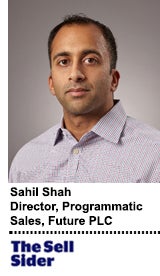“The Sell Sider” is a column written by the sell side of the digital media community.
Today’s column is written by Sahil Shah, head of programmatic sales, in North America for Future plc.
The phrase “walled garden” has carried a negative connotation in the advertising space for a while. It evokes exclusivity, a lack of interoperability, and the specter of Big Tech exerting control over the ad industry.
These days, more publishers are considering walled garden approaches of their own as they compete for ad revenues and put to use their increasingly valuable first-party data. The best course for publishers, however, isn’t to reproduce the closed-off spaces that have come to define the digital ad space. It’s rather to build up the walls that protect first-party data assets—while also investing in bridges and gates that allow access to them.
Balancing protection and access
Actually, walled gardens were originally more about protection than exclusion: the walls were meant to shelter the plants from the elements more than to keep people out. The walls had access points so that visitors could enter and exit. Publishers need to keep that in mind right now if they want to succeed in a post-cookie environment: data and consumer touchpoints have to be secure, but they also need to remain accessible to selected brand partners.
To better grasp this concept, let’s consider it through the prisms of two components: protection and access.
The first-party data that advertisers are sitting on requires protection. Large-scale publishers have massive audiences that can grant advertisers the scale that they will still need, even after cookie deprecation. They also have exclusive insights into what these audiences are reading, how long they’re reading it, how much they’re reading, and what kinds of content inspire them to convert, whether conversion means a purchase, a sign-up, or another type of action. Because they possess this data, publishers will be in a great position to leverage customer purchase intent signals across their sites after third-party cookies are gone.
Needless to say, that data is incredibly valuable, and it’s why so many of the ad industry’s post-cookie conversations have revolved around publisher solutions. Accessing these rich insights at scale will be crucial to advertisers’ success in the near future. For their part, publishers need to protect this valuable resource as much as possible as well as develop ways for advertisers to more easily target unique audiences across their sites.
Clear, safe ways to get in
The best way forward isn’t for publishers to keep everyone out in a mission to protect their data. It’s rather for them to build protected, secure ecosystems that also offer clear, safe routes in to the insights they possess. Data and audience insights that derive from site visitors are incredibly important, but they realize their full value only when shared with brand publishers, who can use them to better deliver campaigns within the contained environment.
Advertisers are currently taking inventory of their own first-party data resources so that they can continue to reach their desired audiences once cookies go away. Publishers are uniquely situated to help match their audiences and insights with brands’ first-party data, creating the detailed, granular targeting that brands expect. The more interoperability that publishers can deploy, the better it is for them and for advertisers.
The reality is that advertisers have come to rely on programmatic and high-speed decisioning when making their buys, and that’s unlikely to change even given the loss of third-party cookies and audience signals. Private marketplace deals between publishers and advertisers will not only continue, but likely become more common given the more limited access to first-party data in the open exchange.
It’s critical for publishers to build these pathways into their walled gardens, pathways that will beckon advertisers to come in and enjoy the scenery. The big powers of digital advertising shouldn’t close themselves off.
Publishers’ beautiful environments
While publishers are right to protect what they have, they need to think about what they’re protecting it from. They should be protecting themselves from the winds that every major new government or tech company policy change or regulation whips up — and not from their partners and potential customers.
Building access points into their walls lets them share with the other members of their ecosystem the beautiful environments they’ve built, even as they still protect their customer relationships.












